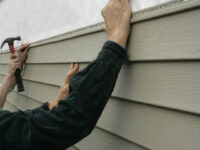How Roofing Maintenance Can Keep Your Home in Top Condition
Roofing Columbus GA is an essential part of keeping your home in top condition. It can help prevent major problems like sagging roofs and water leaks.
Check for shingles that are loose or damaged, as well as caulking around vent pipes and chimneys. Look for moss or mildew growth as well.
Gutters are essential for keeping water off your roof and away from the foundation of your home. However, they need a bit of maintenance to function properly. Gutters can become clogged with leaves, twigs, and other debris, which means water isn’t draining correctly. This can cause damage to your roof, siding, and foundation. Cleaning your gutters is an easy way to keep them working properly and protect your home from water damage.
Gutter cleaning can be done from a ladder or by using a telescopic water pole attached to a hose. If you decide to clean your gutters from a ladder, make sure you use the proper safety precautions. Use a ladder stabilizer to ensure it is secure, and have a friend hold the ladder when you are on it. Also, wear trustworthy work boots and eye protection when cleaning the gutters to prevent falling debris from hitting you in the face.
After you remove the debris from your gutters, take a look to see if there is any moss, lichen, or algae growth that needs to be removed. If there is, a hose and a sprayer with a high-powered nozzle can remove it quite easily. You should then scrub the gutters to ensure they are clean and inspect them for any leaks or cracks that need to be repaired.
Cleaning your gutters on a regular basis can help reduce the chances of ice dams forming. These are caused when melting snow or ice gets into your gutters and causes them to clog. When this happens, it prevents water from draining, which can lead to the thawing of the ice and snow underneath your roof shingles and damage your home.
Keeping your gutters free of debris can also prevent tree branches from scraping the roof, which can cause additional wear and tear on the shingles. Make sure to trim any low-hanging branches that are within a few feet of the gutters and roof, especially during stormy weather. Keeping your gutters and tree branches trimmed regularly can also save you money on costly repairs in the future.
Trim tree branches
The branches of trees around your roof should be trimmed regularly to prevent damage and debris from falling on the roof. This will also help to keep leaves from piling up on the shingles and absorbing moisture, which can lead to roof rot. Inspect your tree branches to see if they are overhanging the roof, and make sure to trim them before stormy weather hits. If you have large trees that are close to the house, consider hiring a professional tree service to come twice a year to trim the branches so they are not rubbing against or hanging over your roof.
When trimming, make sure to remove any branches that are growing toward the center of the tree or growing outward from the crown. These branches are more susceptible to wind damage and will not help support the structure of the tree. You should also thin the tree by removing no more than one-fourth of the living crown at any given time. This will help the remaining dominant branch become stronger and will also reduce the amount of wind block.
Avoid leaving stubs of removed branches, as they are difficult to seal, creating a point of entry for insects and moisture. This will compromise the tree’s natural defenses and allow fungus to enter. Instead, I saw a cut on the underside of the branch about a foot away from where it meets the trunk. Next, I saw another cut through the top side of the branch, slightly farther down from the first underside cut. Finally, I sawed off the stub.
Some species of trees, such as elms, hornbeams, serviceberries, hickories, and Osage oranges, naturally form narrow, V-shaped junctures. These are inherently weak, especially with wind or ice damage, and require corrective pruning to strengthen the overall structure of the tree.
Never use wound paint to seal pruned wounds on a tree, as this can interfere with the natural healing process of the wood. A well-healed pruning scar is perfectly normal and helps protect the tree from decaying organisms. Using wound paint will prevent this process from taking place, which can leave the tree vulnerable to diseases and insect infestations.
Inspect the flashing
Flashing is essentially what connects your roof to the sides of your house and around windows, dormers, chimneys, and other openings. It’s made of water-proof materials like aluminum, copper, and galvanized steel and helps to divert rainwater, snow melt, and other moisture away from your home. It’s also a major part of your roof’s structure and needs to be in good condition so that leaks don’t occur.
Unfortunately, most people never check their flashers. It’s important to do so because if the flashing is damaged, it can lead to leaks and other problems. Fortunately, this is something that can be addressed pretty easily. First, a homeowner should make sure that their gutters are clear and free of debris that could cause blockages. They should also make sure that downspouts are firmly attached and are carrying the water away from their homes.
Next, a home inspector should get up on the ladder and take a look at the flashing. Trying to determine its condition from the ground is not going to be very accurate and is not recommended. They should be looking for any caulking that is cracked, pitted, or missing. It is also a good idea to do some general cleaning of the flashing, especially if it has been exposed to sunlight for long periods of time. Aluminum tends to oxidize over time and can lose its protective properties. If the oxidation is severe, it’s a good idea to replace the flashing section.
Finally, home inspectors should check the integrity of the flashing around any chimneys or other penetrations in the roof. They should also pull on any cables or conductor poles and verify that they are securely fastened with little to no slack. They should also inspect the flashing around roof-mounted equipment curbs for signs of rot or looseness that can lead to the failure of the equipment and allow water intrusion.
Although this isn’t a difficult job, and most professional inspectors do it, it’s a good idea for homeowners to learn how to inspect their own flashing in order to keep it in good condition and prevent any potential leaks. A small leak can be very costly and is one of the most common reasons for a roofing repair.
Inspect the shingles
The shingles on your roof are your first line of defense against the elements. They are subject to direct sunlight, wind, acid rain, and ice, which can cause damage even if the underlying materials are still in good condition. Inspecting your shingle roof regularly from the ground or through a window will help you keep it in great shape.
During your inspection, look for:
Loose or missing shingles should be replaced immediately. Any shingles that show signs of heavy wear or degradation (bald spots, granule loss, or severe curling) should be replaced as well. Cracked and loose shingles can allow water to penetrate the roof, leading to rot or mold inside the home.
Examine the eaves troughs for signs of water penetration, and check the caulking around the flashing and vent pipes for any areas that may need to be resealed. Also examine the rubber boots that seal the plumbing vent pipes to your roof for any cracks or deterioration.
A good shingle roof should last 17 years, but it’s important to inspect the material to see how it is holding up. Look for piles of colored grit from asphalt shingles in the gutters; this is a sign that the shingle’s life is about to end.
During your inspection, look for any cracks or holes in the shingle tiles as well as the edges of the shingles. If you find any cracked or damaged tiles, it is best to call a professional for repairs.
It’s not always possible to get on a ladder or step onto the roof and visually inspect it, but if you can, this will be helpful. If you are not comfortable doing this, it’s okay to use a binocular to see the roof from your yard or a neighbor’s house across the street.
Make sure you are clear of debris and leaves that could accumulate and retain moisture on the roof. Also, look for any branches that are hanging close to or over the roof and need to be trimmed. Branches that hang over the roof collect a lot of moisture and can eventually start to rot the tiles, leading to leaks and other problems.






